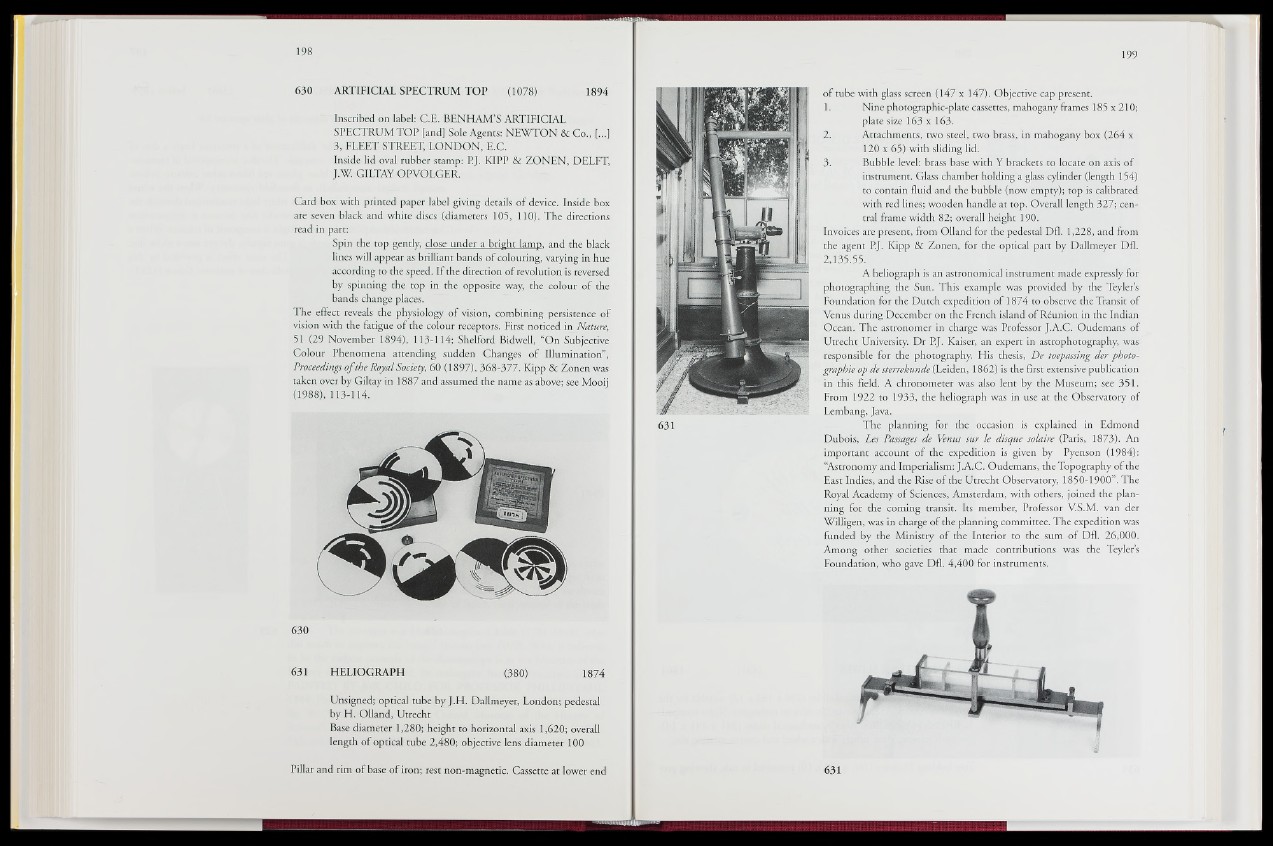
630 ARTIFICIAL SPECTRUM TOP (1078) 1894
Inscribed on label: C.E. BENHAM’S ARTIFICIAL
SPECTRUM TOP [and] Sole Agents: NEWTON & Co., [..,1
3, FLEET STREET, LONDON, E.C.
Inside lid oval rubber stamp: P.J. KIPP & ZONEN, DELFT,
J.W. GILTAY OPVOLGER.
Card box with printed paper label giving details of device. Inside box
are seven black and white discs (diameters 105, 110). The directions
read in part:
Spin the top gently, close under a bright lamp, and the black
lines will appear as brilliant bands of colouring, varying in hue
according to the speed. If the direction of revolution is reversed
by spinning the top in the opposite way, the colour of the
bands change places.
The effect reveals the physiology of vision, combining persistence of
vision with the fatigue of the colour receptors. First noticed in^Nature,
51 (29 November 1894), 113-114; Shelford Bidwell, “On Subjective
Colour Phenomena attending sudden Changes of Illumination”,
Proceedings o f the Royal Society, 60 (1897), 368-377. Kipp &Zo nen was
taken over by Giltay in 1887 and assumed the name as above; see Mooij
(1988), 113-114.
630
631 HELIOGRAPH (380) 1874
Unsigned; optical tube by J.H. Dallmeyer, London; pedestal
by H. Olland, Utrecht
Base diameter 1,280; height to horizontal axis 1,620; overall
length of optical tube 2,480; objective lens diameter 100
Pillar and rim of base of iron; rest non-magnetic. Cassette at lower end
631
of tube with glass screen (147 x 147). Objective cap present.
1. Nine photographic-plate cassettes, mahogany frames 183 x 210;
plate size 163 x 163.
2. Attachments, two steel, two brass, in mahogany box (264 x
120 x 65) with sliding lid.
3. Bubble level: brass base with Y brackets to locate on axis of
instrument. Glass chamber holding a glass cylinder (length 154)
to contain fluid and the bubble (now empty); top is calibrated
with red lines; wooden handle at top. Overall length 327; central
frame width 82; overall height 190.
Invoices are present, from Olland for the pedestal Dfl. 1,228, and from
the agent P.J. Kipp 61 Zonen, for the optical part by Dallmeyer Dfl.
2,135.55.A
heliograph is an astronomical instrument made expressly for
photographing the Sun. This example was provided by the Teyler’s
Foundation for the Dutch expedition of 1874 to observe the Transit of
Venus during December on the French island of Reunion in the Indian
Ocean. The astronomer in charge was Professor J.A.C. Oudemans of
Utrecht University. Dr P.J. Kaiser, an expert in astrophotography, was
responsible for the photography. His thesis, De toepassing der photo-
graphie op de sterrekunde (Leiden, 1862) is the first extensive publication
in this field. A chronometer was also lent by the Museum; see 351.
From 1922 to 1933, the heliograph was in use at the Observatory of
Lembang, Java.
The planning for the occasion is explained in Edmond
Dubois, Les Passages de Venus sur le disque solaire (Paris, 1873). An
important account of the expedition is given by Pyenson (1984):
“Astronomy and Imperialism: J.A.C. Oudemans, the Topography of the
East Indies, and the Rise of the Utrecht Observatory, 1850-1900”. The
Royal Academy of Sciences, Amsterdam, with others, joined the planning
for the coming transit. Its member, Professor V.S.M. van der
Willigen, was in charge of the planning committee. The expedition was
funded by the Ministry of the Interior to the sum of Dfl. 26,000.
Among other societies that made contributions was the Teylers
Foundation, who gave Dfl. 4,400 for instruments.
631